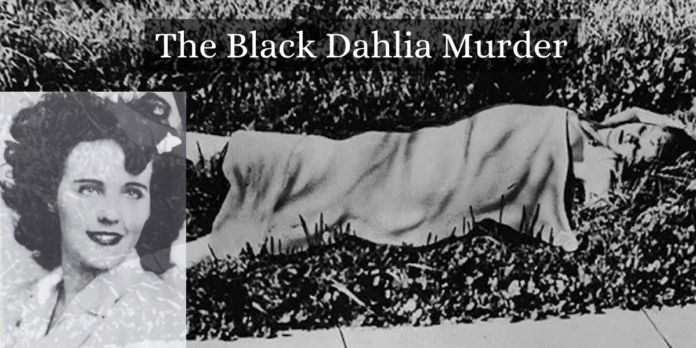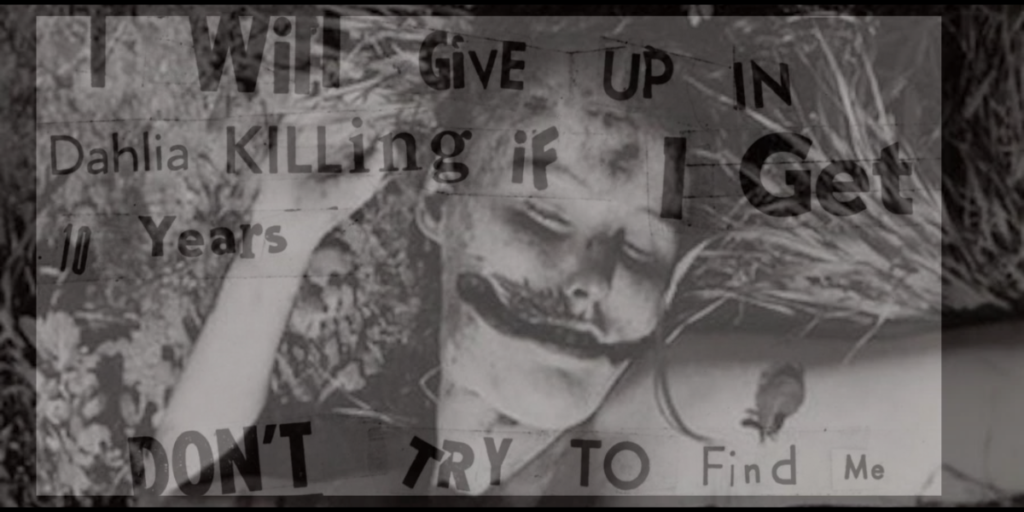On January 15, 1947, the body of Elizabeth Short, forever immortalized as the “Black Dahlia,” was discovered in a vacant lot in the Leimert Park neighborhood of Los Angeles. This gruesome and shocking crime has since become one of the most infamous unsolved murders in American history. The moniker Black Dahlia was posthumously bestowed upon Short, inspired by her striking appearance and a film noir that was popular at the time, “The Blue Dahlia.” The Black Dahlia Murder remains a chilling enigma and serves as a poignant reflection of post-war America’s darker side.
The Discovery and the Details
Betty Bersinger was walking with her young daughter when she stumbled upon what she initially thought was a discarded store mannequin. Upon closer inspection, she realized with horror that it was a woman’s severed body. Elizabeth Short’s body had been meticulously cut in half at the waist, drained of blood, and posed in a manner suggesting both ritualistic elements and deep psychopathy. The brutality of the crime, coupled with the media’s sensational coverage, quickly propelled the case into the national spotlight.
Elizabeth Short: The Victim
Elizabeth Short was born in 1924 in Hyde Park, Massachusetts. She moved to Los Angeles with dreams of becoming a movie star, a common aspiration in the glittering yet ruthless world of 1940s Hollywood. Short’s striking beauty and enigmatic allure made her a fixture in the Hollywood social scene, but her life was marred by instability and transient living conditions. She was often described as a loner, frequently seen in bars and nightclubs, attempting to ingratiate herself with those who could help her achieve her Hollywood dreams.
Despite the mystery that shrouded her life, Short’s murder overshadowed her ambitions and personality, turning her into a symbol of lost innocence and the dark side of the American dream.
The Investigation and Suspects
The Los Angeles Police Department (LAPD) launched an extensive investigation, questioning over 150 suspects. However, the investigation was hampered by numerous factors, including media interference, the transient nature of post-war Los Angeles, and internal issues within the LAPD. Several promising leads emerged but ultimately led nowhere, adding to the frustration of law enforcement and the public.
One of the most intriguing suspects was George Hodel, a Los Angeles physician with a dubious past. His son, Steve Hodel, a former LAPD detective, has argued compellingly in several books that his father was the Black Dahlia killer. Steve Hodel’s investigation unearthed numerous pieces of circumstantial evidence, including photographs and entries in George Hodel’s journals, which he believes point to his father’s involvement in the crime.
Other suspects included Mark Hansen, a nightclub owner who was acquainted with Short, and various transient men who had fleeting connections to her. Despite the plethora of suspects and theories, no one has ever been formally charged with the murder of Elizabeth Short.
Media Frenzy and Cultural Impact
The Black Dahlia murder case captivated the media and public, with newspapers competing for the most sensational headlines. This relentless coverage turned Elizabeth Short into a posthumous celebrity, overshadowing her identity and transforming her into a symbol of the era’s moral decay. The press’s invasive tactics, including publishing lurid details of Short’s life and the gruesome crime scene photos, contributed to a frenzy that influenced public perception and the investigation itself.
The case has since permeated popular culture, inspiring numerous books, films, and television series. James Ellroy’s novel “The Black Dahlia,” later adapted into a film, fictionalized the events surrounding the murder, while television series such as “American Horror Story” have incorporated elements of the case into their storylines. These portrayals, while often dramatized, reflect the enduring fascination with the mystery and horror of the Black Dahlia murder.
Legacy and Ongoing Mystery
Seventy-seven years after Elizabeth Short’s tragic death, the Black Dahlia case remains unsolved, a haunting reminder of the potential for evil that can lurk behind the facade of glamour and success. The case has sparked numerous theories and debates among criminologists, historians, and amateur sleuths, each seeking to uncover the truth behind one of the most notorious crimes in American history.
The continued interest in the Black Dahlia case underscores society’s enduring obsession with mystery and the macabre. It serves as a stark reminder of life’s vulnerability and transient nature, particularly in a city where dreams are made and shattered. The legacy of Elizabeth Short, the Black Dahlia, is not just in the gruesome details of her death, but in the broader narrative of human curiosity, the pursuit of justice, and the quest to understand the darkness within.
Conclusion:
In conclusion, the Black Dahlia murder remains a compelling and disturbing chapter in the annals of American crime history. It encapsulates the post-war era’s fears and fascinations, reflecting a society grappling with rapid changes and the darker aspects of human nature. As long as the mystery remains unsolved, the story of Elizabeth Short will continue to captivate and haunt future generations.





